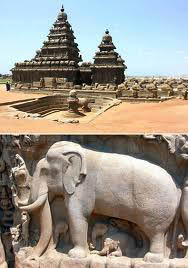Name of the Temple |
|
Location |
- Located 60 km south of Chennai, this town is enriched with a number of heritage monuments.
|
| How to reach there? |
- By Air: The nearest airport is the Chennai International airport, which is located about 60 km away from Mahābalipuram. From the airport take the East-Coast-Road south to reach Mahābalipuram.
- By Train : The nearest railway station is Cheṅgalpaṭṭu (29 km). From there take the State Highway 58 west to Mahābalipuram.
- By Road : Mahābalipuram is well connected through the East-Coast-Road in Chennai.
|
Rulers/builders and Time Period |
- Mahābalipuram temples whose architecture was inspired by the Pallava Art were built during the period 830 - 1100 AD.
- Five rathhas were constructed during the dynasty of King Mahendravarman I and his son Narsimhavarman I.
|
Deity/Deities |
- The shrine temple has three shrines. The main shrine and the smaller second is dedicated to Lord Śhiva and the third small shrine is dedicated to Lord Viṣhṇu.
- Sthhalaśhayana Perumal Temple is another important Mahābalipuram temple, which is counted amongst one of the 108 Divya Dhesams. It is a small temple, adorned with two major shrines of Lord Sthalaśhayana Perumāḷ and Nilamaṅgai Thayār.
- The temple also has another separate shrine of Lord Narasimha that reflects the Pallava style of architecture.
|
Architecture Style |
- There are total 11 excavated temples in Mahābalipuram, called Manḍapas, two open air bas-reliefs, out of which one is incomplete. But the most famous Mahābalipuram temple is a rock cut temple, it is also known as ‘Rathha’. The Pancha Rathhas is one of the best examples of monolith Indian rock cut architecture, dates back to the late 7th century.
- The Shore temple is so named because of its unique location as it overlooks Bay of Bengal. This temple is an architectural masterpiece, made of granite blocks during 8th century AD. It is a five-storey temple with pyramidal structure of 60 feet height.
- Arjuna's Penance is one of the largest bas reliefs in the world, carved during mid 7th century. Standing at the height of 43 feet this massive structure is carved on the two adjoining monolithic rocks. The total length of Arjuna's Penance is around 96 feet.
|
Special Reference to Fine Arts |
- Coastal area studded with small hills ideal for the creation of cave temples, stone carvings, etc. The Pallavas created many marvelous monuments like the sculptural panels, caves, monolithic rathhas and temples. These monuments carved out of solid rock, though ravaged by the sea and wind, still bear testimony to the magnificent heritage of Dravidian architecture.
- The Mahābalipuram art can be divided into four categories which are open air bas-relief, structured temples, man-made caves and rathas. The most important attraction in Mahābalipuram are the famous Arjuna's Penance, the Krishna Manḍapa and the beautiful Shore Temple. Sixteen man-made caves in different stages of completion are also scattered throughout the area.
- The Shore Temple, one of the oldest in South India, stands on the sea shore with its paved forecourts. Sculpture Museum is located south of the bus stand in East Raja Street and has about 3000 exquisite sculptures made by local artisans in wood, metal, brass and even cement. The museum is associated with the College of Traditional art and Architecture which has produced many fine sculptures.
|
Other Special Features |
- The Pallavas were instrumental in the transition from rock-cut architecture to stone temples. The earliest examples of Pallava constructions are rock-cut temples dating from 610–690 CE and structural temples between 690–900 CE.
- A number of rock-cut cave temples bear the inscription of the Pallava king, Mahendhravarman I and his successors.
|
Any Other Remarks |
- Mahābalipuram has been categorized as a UNESCO World Heritage Site since most of the monuments were built between the 7th and 9th centuries.
- The modern city of Mahābalipuram was established by the British in 1827.
- Pongal is the most revered and awaited festival of the Tamils. Pongal is celebrated in mid-January every year. The festival is marked by joy and festivities at Mahābalipuram.
- Māsimagam and Brahmothsavam - These Sthalaśhayana Perumāḷ temple festivals are renowned and are in the month of March.
|
Special Reference to Performing Arts: |
- Thirumaṅgai Āzhvār and Bhūthathāzhvār have composed beautiful Pāsurams on Lord Sthalaśhayana Perumāḷ and his consort Nilamaṅgai Thāyār. They are part of the compositions in Nālāyira Dhivya Prabandham.
- Mahābalipuram Dance Festival is an event where artists from all over the country accumulate to perform. It is celebrated in the month of January & February every year. The Shore Temple figures as the location of this festival and divine music from the musical instruments mixes with the natural poetic music of the wind and the sea.
|
Bibliography |
|















